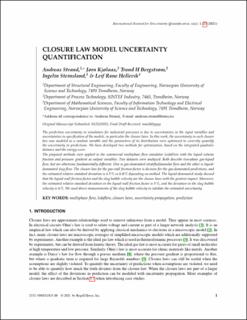| dc.contributor.author | Strand, Andreas | |
| dc.contributor.author | Kjølaas, Jørn | |
| dc.contributor.author | Bergstrøm, Trond Harald | |
| dc.contributor.author | Steinsland, Ingelin | |
| dc.contributor.author | Hellevik, Leif Rune | |
| dc.date.accessioned | 2021-11-15T11:34:08Z | |
| dc.date.available | 2021-11-15T11:34:08Z | |
| dc.date.created | 2021-11-13T12:26:23Z | |
| dc.date.issued | 2021 | |
| dc.identifier.issn | 2152-5080 | |
| dc.identifier.uri | https://hdl.handle.net/11250/2829560 | |
| dc.description.abstract | The prediction uncertainty in simulators for industrial processes is due to uncertainties in the input variables and uncertainties in specification of the models, in particular the closure laws. In this work, the uncertainty in each closure law was modeled as a random variable and the parameters of its distribution were optimized to correctly quantify the uncertainty in predictions. We have developed two methods for optimization, based on the integrated quadratic distance and the energy score. The proposed methods were applied to the commercial multiphase flow simulator LedaFlow with the liquid volume fraction and pressure gradient as output variables. Two datasets were analyzed. Both describe two-phase gas-liquid flow, but are otherwise fundamentally different. One is gas-dominated stratified/annular flow and the other is liquid-dominated slug flow. The closure law for the gas-wall friction factor is decisive for the gas-dominated predictions, and the estimated relative standard deviation is 4.5% or 8.0% depending on method. The liquid-dominated study showed that the liquid-wall friction factor and the slug bubble velocity are the closure laws with the greatest impact. Moreover, the estimated relative standard deviation in the liquid-wall friction factor is 5%, and the deviation in the slug bubble velocity is 4%. We used direct measurements of the slug bubble velocity to validate the estimated uncertainty. | en_US |
| dc.language.iso | eng | en_US |
| dc.publisher | Begell House | en_US |
| dc.title | Closure Law Model Uncertainty Quantification | en_US |
| dc.type | Peer reviewed | en_US |
| dc.type | Journal article | en_US |
| dc.description.version | acceptedVersion | en_US |
| dc.rights.holder | This is the authors' accepted manuscript to an article published by Begell House. | en_US |
| dc.source.journal | International Journal for Uncertainty Quantification | en_US |
| dc.identifier.doi | 10.1615/Int.J.UncertaintyQuantification.2021037714 | |
| dc.identifier.cristin | 1954255 | |
| cristin.ispublished | true | |
| cristin.fulltext | postprint | |
| cristin.qualitycode | 1 | |
